Diode lasers are finding traction in new applications, thanks to advances in wavelength combining, new wavelengths and improvements in production.
Thanks to their high efficiency, compact size and low power requirements, commercial laser diodes are a commodity component in numerous everyday devices, including CD and DVD players, scanner/printers, laser pointers, and bar-code readers. When laser diodes are integrated into a system, the result is a diode laser. Diode laser technology, found in numerous applications from industrial processing to telecom, health care and military, is ubiquitous and continually evolving. The commercial selection of diode lasers is therefore complex, specified by center wavelengths from UV (190 nm) to IR (3500 nm) and by power output from milliwatts to a few kilowatts, varying according to wavelength (Figure 1).
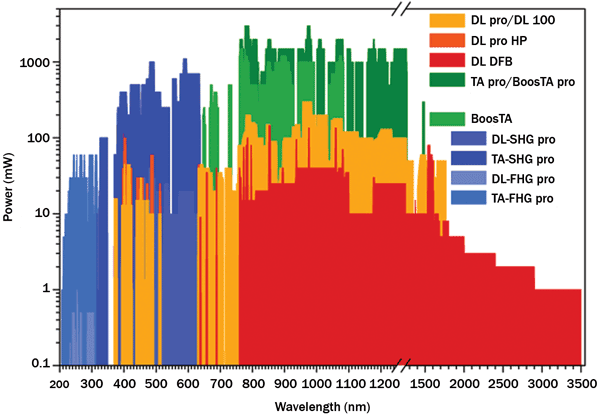
Figure 1. Commercial research-grade diode lasers, including tunable diode lasers, amplified diode lasers and frequency-converted diode lasers, are available in wavelengths from 200 to 3500 nm. Photo courtesy of Toptica.
Industrial processing currently is one of the biggest trending applications for diode lasers. Historically, the first lasers of choice in industrial applications such as sheet-metal cutting were bulky and inefficient CO2 and lamp-pumped Nd:YAG systems, which exhibited output power efficiencies on the order of 10 to 20 percent. Diode-pumped disk and fiber solid-state lasers entered the market next with slightly higher efficiencies in the 30 percent range. In the past 10 years, diode lasers have developed in power and brightness, and with inherently higher efficiencies (sometimes 40 to 50 percent), they are only now reaching viability in the metal-cutting market. Diode lasers suffer from poor beam quality at high power levels, which hinders their advantage over diode-pumped solid-state lasers and fiber lasers in materials processing, and in military and aerospace applications.1 Several types of diode lasers, including multichip lasers, diode laser bars (long arrays of diode lasers), fiber-guided diode lasers and direct diode lasers, are evolving toward next-generation applications.
Direct diode lasers
The use of the term “direct diode” is somewhat ambiguous, originally meaning a diode laser focused directly on a target, as opposed to being merely a pump source. As such, direct diode lasers have poorer beam quality and a larger beam focal spot than fiber lasers (not to be confused with fiber-guided diode lasers), and so they are relatively low in brightness. However, direct diode lasers can offer higher efficiency, reliability and a smaller footprint than other laser technologies. And when produced at high volumes, direct diode lasers are low cost enough for use in telecom and data storage. They are also used in welding and surface treatment of metals during manufacturing processes. According to analysts at Strategies Unlimited, direct diode lasers (applied directly to the application without fiber guiding) are growing as a solution to replace traditional CO2 lasers for metal processing and are projected to represent $237 million in 2017, growing at a CAGR of 15.3 percent through 2017.
Today, direct diode lasers might incorporate the use of fiber coupling or fiber guiding to increase their output power, a relatively new development that enables faster cutting speeds, improved cutting quality, improved energy efficiency and lower maintenance costs. Companies such as Coherent and Apollo Instruments have offered fiber-guided multikilowatt diode laser systems for welding applications for several years. In July 2014, TeraDiode of Wilmington, Mass., introduced the first high-brightness direct diode laser for cutting and welding of metal with 40 percent wall-plug efficiencies (Figure 2). The 4-kW TeraBlade uses a technique patented by MIT’s Lincoln Labs called wavelength beam combining, which uses diode laser bars, a transform lens, a diffraction grating and a focusing lens to superimpose the laser beams. The wavelength beam combining technique scales the output power by the number of emitter elements in the array, up to 4 kW. The TeraBlade laser has a 100-µm-diameter output fiber that delivers a beam-parameter product of 4 mm mrad, which can cut mild steel (the least expensive, most common steel) up to 0.5 in. (12.7 mm) thick with a speed and cut quality comparable to that with disk and fiber lasers.
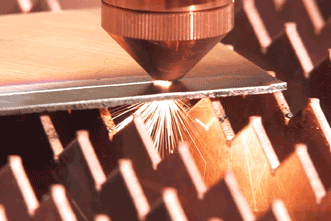
Figure 2. The TeraBlade laser from TeraDiode cuts though a 1/16-in.-thick plate of stainless steel. Photo courtesy of TeraDiode.
In October 2014, JDSU of Milpitas, Calif., in collaboration with Amada of Kanagawa, Japan, introduced the ExC sheet-metal cutting system with a direct diode laser engine featuring up to 2 kW of output power. At Photonics West 2015 in February, JDSU launched five more turnkey fiber laser and direct diode laser systems for machine tool manufacturers. The new systems, which are scheduled to be available the second half of 2015, incorporate JDSU’s Corelight direct diode laser engines and provide output powers of up to 6 kW for cutting parts out of sheets of aluminum and steel. Direct diode systems for metal cutting are a reality, and the race is on to reach higher power and higher brightness.
The new market for diode lasers is similar to when fiber lasers were initially introduced into the market, according to Peter Wang, vice president of Apollo Instruments. People unfamiliar with diode laser applications should consult with a few reputable manufacturers.
“Fiber lasers still have the edge over high-brightness diode laser systems in applications where beam quality is concerned, such as in cutting of medium-thickness steel. But we have seen customers order very high power fiber lasers and then use optics to reduce its beam quality for their applications,” Wang said (Figure 3).
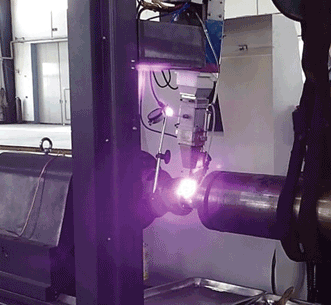
Figure 3. The 3- to 5-kW laser direct focusing system is useful and efficient for cladding and welding applications. Photo courtesy of Apollo Instruments.
Tunable diode lasers
In scientific applications like biophotonics, quantum optics or spectroscopy, researchers require diode lasers that are tunable over a wide band of wavelengths. Progress is being made in this area also, in the form of new diode lasers, new wavelengths and new controllers. In May 2014, Toptica Photonics of Gräfelfing, Germany, launched a continuously tunable laser (CTL), a diode laser smoothly tunable over the ranges of 915 to 985 nm and 1530 to 1620 nm, with output powers of up to 80 mW and 50 mW, respectively (Figure 4). In research-grade applications like molecular spectroscopy, the CTL can scan over 100 nm with no mode-hopping – a new feature enabled by SMILE (patent pending) active control technology. The CTL features narrow linewidths below 100 kHz.
Controllers for diode laser systems are often an afterthought but are critical to effective operation and protection of an often expensive investment.2 In 2014, Toptica also launched a digital laser controller called DLC pro that can, among other tricks, automatically correct for drifts in laser frequency caused by changing environmental conditions. The DLC also enables 20-bit resolution for precise control. Lastly, Toptica announced new wavelengths in its OEM diode laser series iBeam Smart at Photonics West 2015: 505 and 633 nm with record power (80 and 100 mW, respectively). At 633 nm, Toptica also offers the wavelength-stabilized iBeam smart WS, designed to replace HeNe lasers with a compact (100 × 40 × 40-mm) OEM diode laser system with 20 mW of output power.
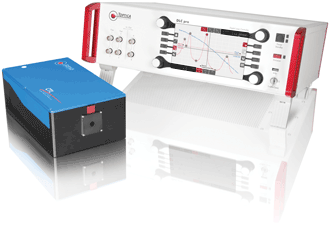
Figure 4. The CTL frequency-converted continually tunable diode laser from Toptica (left) scans over a 100-nm range, mode-hop free. Driver electronics like the DLC pro digital laser controller (right) are a critical part of a diode system that should not be overlooked. Photo courtesy of Toptica.
Pushing boundaries
In medical and lidar applications, diode lasers must be at “eye-safe” IR wavelengths. Military customers prefer 1550 nm due to the invisible stealth nature of the wavelength. The 1470-nm wavelength laser diode is ideal for medical and dermatological applications, such as surgical treatment of varicose veins.
“Laser wavelengths between 1410 and 1550 are considered retinal-safe since the laser radiation is absorbed by the cornea and should not reach the retina,” said Neal Stoker, vice president of sales and marketing at SemiNex of Peabody, Mass. “Of course, any laser used improperly will damage the eye.”
Multichip diode lasers based on indium phosphide (InP) can provide high-power emission at numerous custom wavelengthsbetween 1300 and 1700 nm in the short-wavelength IR (SWIR) region of the spectrum. The new two-chip module (2CM) from SemiNex provides high power output of up to 8 W at 1310, 1470, 1550 and 1625 nm, among others, in a tiny package measuring 52 × 35 mm (Figure 5). The 2CM reaches those unprecedented powers by combining the beams from the two chips into a single fiber rather than into bundled fiber.
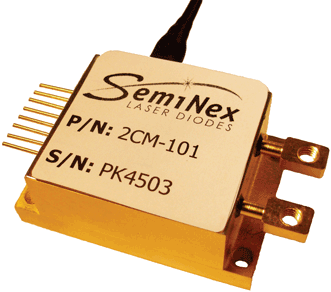
Figure 5. The two-chip module (2CM) diode laser from SemiNex offers unprecedented 8 W of power in a tiny package at SWIR wavelengths. Photo courtesy of SemiNex.
“Customers are requesting higher power, and they want it confined to a single fiber for high brightness,” Stoker said. “Instead of fusion-splicing multiple fiber lasers into a single laser, we combine two diode lasers into a single fiber. This yields a high-power, high-brightness fiber-coupled laser that is easy to mount within OEM applications. It also makes cooling and power easier for large-scale manufacturing.”
And with large-scale manufacturing come high-volume, lower-cost diodelasers. According to Jörg Neukum, director of sales and marketing at Dilas Diodenlaser GmbH of Mainz, Germany, high-volume production is driving standardization and cost reduction.
“We are responding to the demand for reliability, ease of integration, high brightness and reasonable cost with intensive customer relations, quality engineering, superior process control and volume production via automated process technologies.”
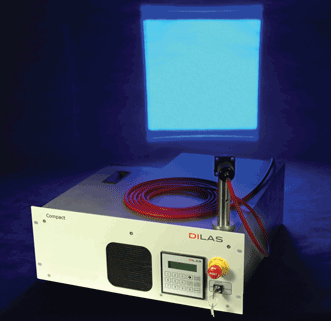
Figure 6. The new visible blue diode laser system at 450 nm from Dilas delivers output power of up to 25 W from a 200-µm fiber. Photo courtesy of Dilas Diodenlaser.
In February this year, Dilas launched a new turnkey fiber-coupled diode laser system at the visible blue wavelength of 450 nm, ideal for illuminating phosphorous materials used in the generation of white light and for processing gold and copper (Figure 6). The new-wavelength laser within the Compact platform is available with up to 25 W of output power from a 200- or 400-μm (NA 0.22) fiber, scalable up to 100 W.
References
1. H. Nasim and Y. Jamil (March 2014). Diode lasers: From laboratory to industry. Opt Laser Technol, Vol. 56, pp. 211–222.
2. V. Coffey (February 2009). Laser-diode power-supply basics: Performance depends on specification. Laser Focus World, p. 60.